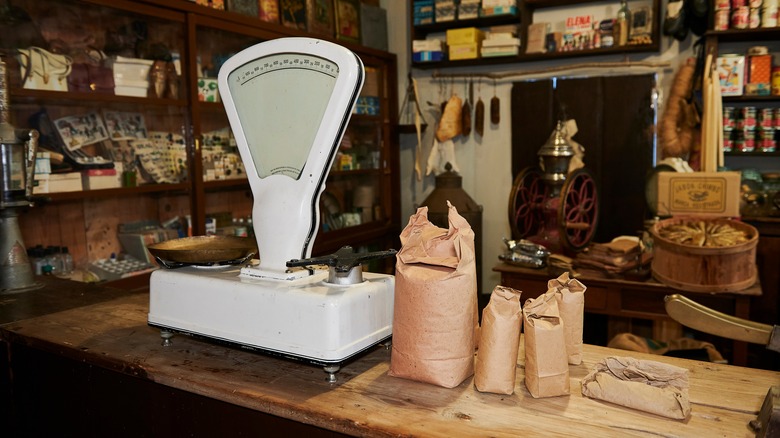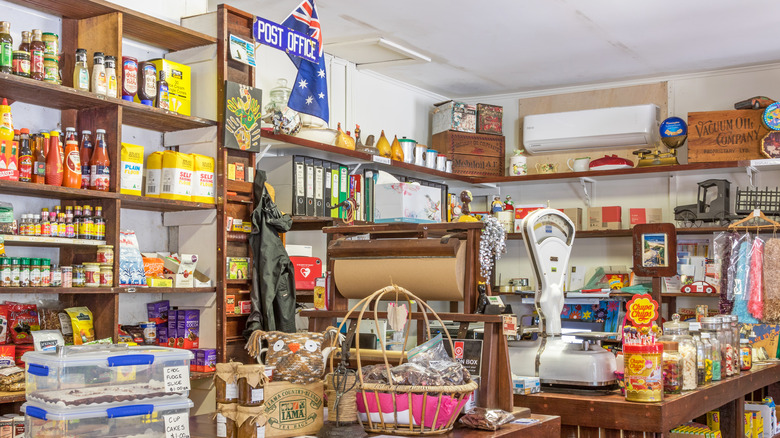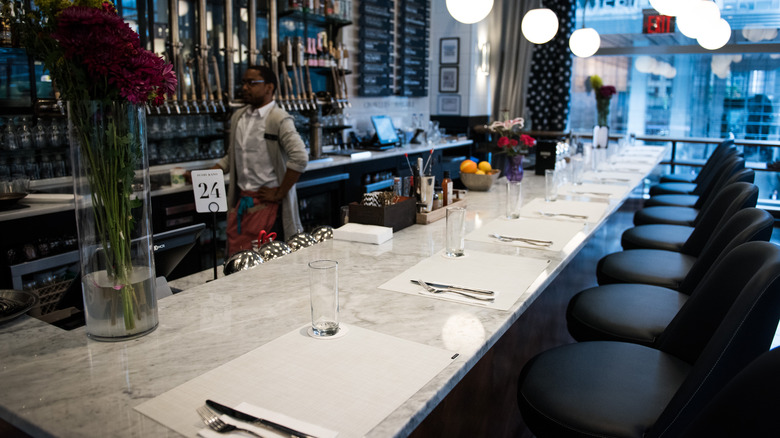What The Word 'Grocery' Originally Meant
The grocery delivery industry had a moment during the pandemic. You might even have the Instacart app downloaded on your phone right now. But, after a long hiatus, in-store grocery shopping is back on the rise – and it turns out the American "grocery" has enjoyed a much more labyrinthian history than just the transition from pushing a clanging metal shopping cart to pressing an "add to cart" button. In fact, the word "grocery" itself used to mean something totally different.
According to the Living History of Illinois and Chicago, what currently comes to mind when you think of a grocery store used to be called a "general store." From the late 1600s until the 1850s, it says, a "grocery" referred to a place people went to drink. Challenge a "Simpsons" fan to imagine Homer hanging out at "Moe's Grocery." Feels kind of wrong, doesn't it? But for barflies from a few centuries ago, it was oh so right.
From grocery to general store to bar
General stores were also called mercantiles, emporiums, or village shops, per Wonderopolis, and they sold everything from food, clothing, and household goods to construction materials. Since they carried everything consumers could need, it makes sense that these general stores emerged as social centers for their communities.
The general store was the successor of the early-American trading post, a la the pioneers, per Encyclopedia Britannica, and the predecessor of the modern "convenience store," via the New World Encyclopedia. General stores, it says, were commonly located at a crossroads — not dissimilarly to your favorite corner bodega today. But, unlike your bodega, shoppers could barter. You'd be hard-pressed to trade a retired T-shirt for a bottle of kombucha.
According to etymology expert Merriam-Webster, the word "grocery" comes from the 14th century Anglo-French "groser," referring to a person who sold by the gross, as in large quantities. By the 1800s, a grocer selling coffee, tea, sugar, and other staple food items could also apply for a liquor license, thereby transitioning the word "grocery" for a time toward the barroom.
The future of grocery
Just as video killed the radio star (thanks, The Buggles), specialty shops killed the general store. By the 1960s, general stores accounted for fewer than 50,000 of 1,763,324 retail stores in the U.S., according to the New World Encyclopedia. Today, general stores primarily endure in small towns and rural communities, but as Wonderopolis notes, big-box stores that sell household goods, clothing, electronics, tools, and groceries today are basically the same concept as a one-stop general store. In fact, the number-one grocer in the U.S. in 2021 was Walmart, according to ScrapeHero.
But what of the grocery bar; did the specialty shops kill it? Today, the line between grocery store and bar is perhaps more blurred than ever before. When DeCicco & Sons became the first grocer in New York to build an in-store bar, competitors "thought we were crazy," says co-owner Chris DeCicco, via Grocery Dive. But, since then, the idea has clearly taken off. A 2016 article by The Wall Street Journal reports that high-dollar grocery stores nationwide were starting to construct wine bars and beer gardens in their stores to encourage shoppers to prolong their grocery run and spend more money. VinePair even humorously outlines the "Seven Stages of Drinking at Whole Foods."
It isn't just massive market franchises boasting bars, either — family-owned Lucky's Market in Cleveland, Ohio, sells wine by the glass for shoppers to sip as they browse. In fact, Arlene's Grocery is a rock n' roll bar in Manhattan's lower east side (never mind that it was established in 1995, long after the term "grocery" had assumed its new meaning). So, it would seem anything is possible for the future of the word.


